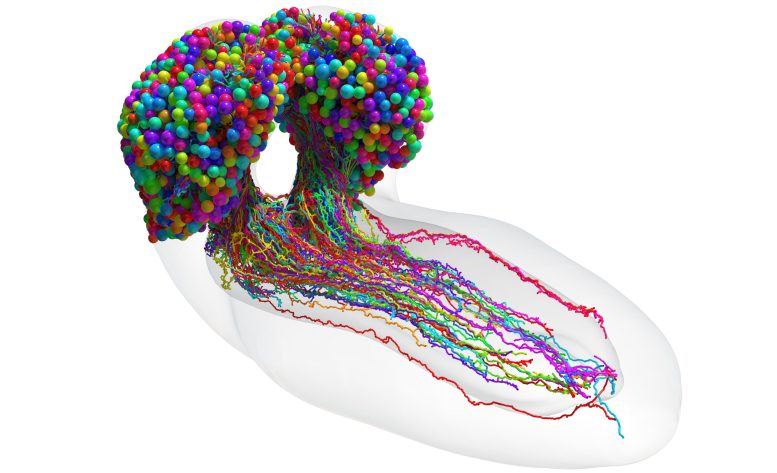
The complete set of neurons in an insect brain, which were reconstructed using synapse-resolution electron microscopy. Credit: Johns Hopkins University/University of Cambridge
Scientists have constructed the first-ever map showing every single neuron and how they’re wired together in the brain of the fruit fly larva.
Researchers have built the first-ever map showing every single neuron and how they’re wired together in the brain of the fruit fly larva.
This huge step forwards in science will ultimately help us understand the basic principles by which signals travel through the brain at the neural level and lead to behavior and learning.
The map of the 3016 neurons that make up the larva’s brain and the detailed circuitry of neural pathways within it is known as a ‘connectome’. It’s the largest complete brain connectome described yet.
Professor Marta Zlatic and Professor Albert Cardona of the Medical Research Council Laboratory of Molecular Biology and the University of Cambridge and colleagues from both the UK and the US led this ground-breaking research. The study was published in the journal Science on March 10, 2023.
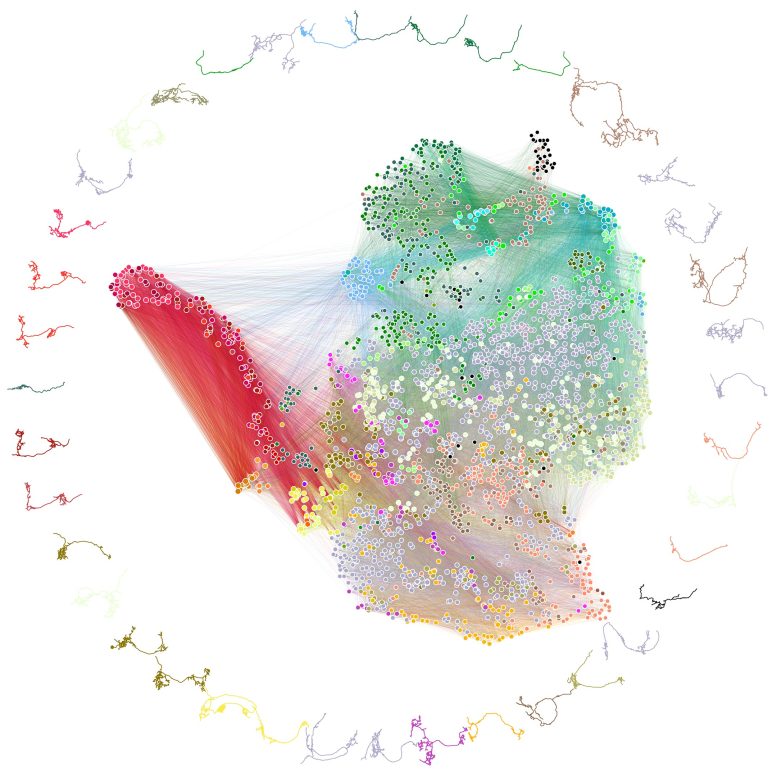
A diagram depicting the connectivity, where neurons are represented as points, and neurons with more similar connectivity are plotted closer together. Lines depict connections between neurons. The border of the figure shows example neuron morphologies. Credit: Johns Hopkins University/University of Cambridge
An organism’s nervous system, including the brain, is made up of neurons that are connected to each other via synapses. Information in the form of chemicals passes from one neuron to another through these contact points.
Professor Zlatic said:
“The way the brain circuit is structured influences the computations the brain can do. But, up until this point, we’ve not seen the structure of any brain except of the roundworm C. elegans, the tadpole of a low chordate, and the larva of a marine annelid, all of which have several hundred neurons. This means neuroscience has been mostly operating without circuit maps. Without knowing the structure of a brain, we’re guessing on the way computations are implemented. But now, we can start gaining a mechanistic understanding of how the brain works.”
Zlatic explained that current technology isn’t yet advanced enough to map the connectome for higher animals such as large mammals. However, she said:
“All brains are similar – they are all networks of interconnected neurons – and all brains of all species have to perform many complex behaviors: they all need to process sensory information, learn, select actions, navigate their environments, choose food, recognize their conspecifics, escape from predators, etc. In the same way that genes are conserved across the animal kingdom, I think that the basic circuit motifs that implement these fundamental behaviors will also be conserved.”
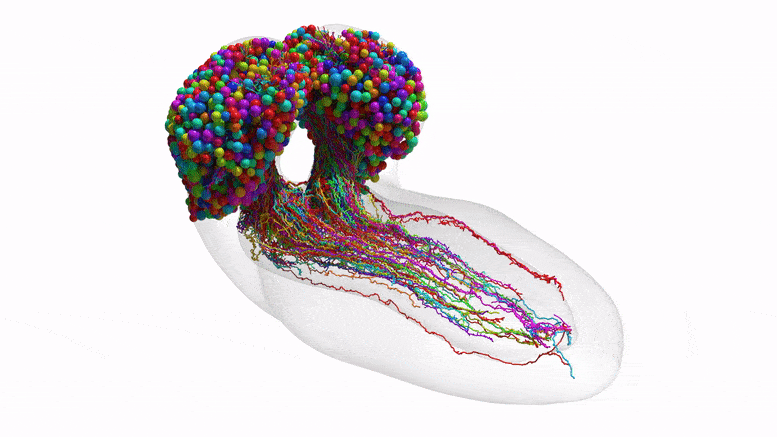
The complete set of neurons in an insect brain. Credit: Johns Hopkins University/University of Cambridge
To build a picture of the fruit fly larva connectome, Zlatic, Cardona and colleagues scanned thousands of slices of the larva’s brain using a high-resolution electron microscope. They reconstructed the resulting images into a map of the fly’s brain and painstakingly annotated the connections between neurons. As well as mapping the 3016 neurons, they mapped an incredible 548,000 synapses.
The researchers also developed computational tools to identify likely pathways of information flow and different types of circuit motifs in the insect’s brain They also found that some of the structural features are exactly like state-of-the-art deep learning architecture.
Zlatic said:
“The most challenging aspect of this work was understanding and interpreting what we saw. We were faced with a complex neural circuit with lots of structure. In collaboration with Professor Priebe and Professor Vogestein’s groups at Johns Hopkins University, we developed computational tools to extract and predict from the structure the relevant circuit motives. By comparing this biological system, we can potentially also inspire better artificial networks.”
Jo Latimer, Head of Neurosciences and Mental Health at the Medical Research Council, said:
“This is an exciting and significant body of work by colleagues at the MRC Laboratory of Molecular Biology and others. Not only have they mapped every single neuron in the insect’s brain, but they’ve also worked out how each neuron is connected. This is a big step forward in addressing key questions about how the brain works, particularly how signals move through the neurons and synapses leading to behavior, and this detailed understanding may lead to therapeutic interventions in the future.”
The next step will be to delve deeper to understand, for example, the architecture required for specific behavioral functions, such as learning and decision making, and look at activity in the whole connectome while the insect is doing things.
For more on this research, see First Complete Map of an Insect Brain.
Reference: “The connectome of an insect brain” by Michael Winding, Benjamin D. Pedigo, Christopher L. Barnes, Heather G. Patsolic, Youngser Park, Tom Kazimiers, Akira Fushiki, Ingrid V. Andrade, Avinash Khandelwal, Javier Valdes-Aleman, Feng Li, Nadine Randel, Elizabeth Barsotti, Ana Correia, Richard D. Fetter, Volker Hartenstein, Carey E. Priebe, Joshua T. Vogelstein, Albert Cardona and Marta Zlatic, 10 March 2023, Science.
DOI: 10.1126/science.add9330

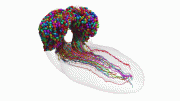


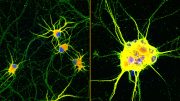


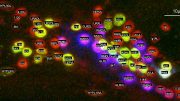
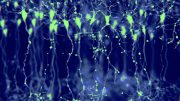
Please help to pull this trough.
In contrast to public impressions, involuntary treatment is a staple of all medical care for severe and life-threatening conditions.
There are hundred thousands of people in urgent need of treatment and often refuse it.
Families and communities suffer because most not-affected populations think we are taking away basic human rights in a case of involuntary treatment.
Consider, for instance, an unconscious victim of a car accident who is severely injured. Do we wait on treatment? Do we wonder if the person really wants treatment? Of course not. Medical professionals simply proceed with the type of treatment that most individuals would choose in such a situation. Doctors and nurses opt to intervene to preserve life and restore health, as much as they are able. As the injured individual returns to normal consciousness, they can decide for themselves whether to accept or reject further treatment.
As of now we wait until a horrible act is revealed then we consider incarceration or hospitalization.
Unfortunately involuntary treatment raises the specter of coercive psychiatry, and the image of the psychiatrist as a power-hungry sadist. It revives and reinforces the hoary impression that the psychiatrist is an enforcer of social control rather than as a healer of the mind. And this is an image that very few psychiatrists wish to revisit.
We need prevention instead of punishment, crime and misery.
We need much more funds for faster research for more aimed mental treatment. We need to treat before the mental illness grows more since most mental illnesses are progressive.
We need to diminish sale of illicit drugs and alcohol and a drastic public education of all mental/addiction illnesses.
Please help millions by raising awareness and let’s take action and help US to heal. 95% of crime and reckless behavior is due temporary and chronic mental illnesses.
Please let me know how I can help.
Anosognosia, this is The inability to understand that you are ill. It is very common among the most severely mentally ill. They are unable to make an informed decision about treatment for their illness because they are not aware that the illness exists.
Unfortunately, mental health “advocates” and patient “autonomy” experts do not consider anosognosia in their treatment recommendations. For this reason, the most extreme of mentally ill individuals will never receive any care. All they need to do is say, “I’m not ill,” and their wishes are respected, even though it is obvious that they are indeed desperately ill—but unaware of it. Is that really autonomy? No. Because if these patients knew they were ill, they would actually seek out and demand treatment. It’s like refusing to do a blood test and letting patients believe they don’t have cancer. You are doing them no favors by allowing them to live a dangerous lie.
What happens when a mom is sick? What happens when her children and the entire family is traumatized and suffering and unable to escape the suffering as mom does crazy acts and remains untreated? What if she pulls out smoke detectors, nails windows shut, wallpapers with tin foil, hoards newspapers, and throws out all the food because “it all has poison in it?” What then?
Well it turns out that the family members have zero rights at all. Everything is about the rights of the mentally ill person to psychologically abuse, torture, endanger, and destroy the others and themself in the home. The ONLY escape for the family is perjury, lying to the court about homicidal or suicidal threats in order to get the family member a 72 hour hold and maybe—MAYBE a sweet, precious injection of antipsychotic that will bring a bit of normalcy until it wears off a month later.
Everything allows the mentally ill person to destroy the life of everyone and themself.